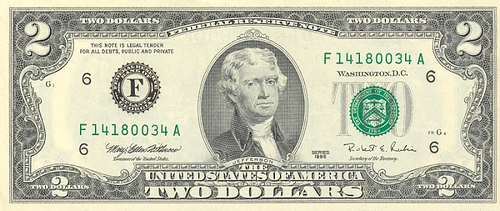I recently discovered that the branch manager at the Wells Fargo bank I frequent can order a bound stack of two dollar bills on request. This is rather handy since banks don’t normally have any just “lying around.”

Upon discovering this fact, I promptly requested a stack of 100 bills, or $200. As I left the bank that fateful afternoon, giddy with excitement over my fresh stack of uncirculated two dollar bills (I was rather lucky), I decided to embark on a little project: I want to see if I can reintroduce two dollar bills into the local economy.
The ground rules I’ve been following:
- Only spend bills at local businesses, tips are a great way to get back into circulation as soon as possible
- Record all serial numbers of bills whenever a withdrawal is made
- Don’t spend more than 4-5 bills at a time, don’t want to run the risk of irritating whoever I’m paying too much
Thus far I’ve spent about $80 in twos between morning coffee and breakfast and a couple of other beer-related expenses and the reactions have been surprisingly boring. I had hypothesized that folks would have been a little bit more surprised or taken-aback by the sight of 3-4 crisp, sequential, two dollar bills.
I suppose outside of an election year, there’s nothing that really surprises most San Franciscans.
The bills
Since I’ve been recording the serial numbers on the bills, here’s a quick break down of the districts this money was printed for:
Legend A: Boston, C: Philadelphia, E: Richmond, F: Atlanta, G: Chicago, H: St. Louis, I: Minneapolis and L: San Francisco.
- A: 1
- C: 2
- E: 1
- F: 10
- G: 1
- H: 2
- I: 14
- L: 169
I’ve not yet seen bills from New York (B), Cleveland (D), Kansas City (J) or Dallas (K).
I personally find both two dollar bills and the movement of money interesting, EC (my wife) on the otherhand refuses to spend them.
Can’t win them all.